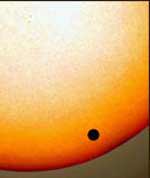
Image credit: NASA
Want to see the 2004 Transit of Venus? Be prepared to wake up early.
On Tuesday morning, June 8th, for the first time since 1882, Venus will pass directly between Earth and the Sun. For six hours the planet’s black silhouette will crawl across the face of our star. It might be a pretty sight, or not. No one can say for sure because no one alive today has seen a transit of Venus.
If you live near the east coast of North America, you can see the crossing. The transit will be underway at dawn and visible for as much as two hours after sunrise.
Before you read the rest of this story, a reminder: Never look at the Sun without eye protection. The early morning Sun rising through the mist, reddened and dimmed by distant clouds, is so tempting; it seems safe to stare. Don’t! Even a low-hanging Sun can cause eye damage. Proper transit-watching techniques are discussed below.
The transit begins at 1:13 a.m. EDT (in the middle of the night) and ends at 7:26 a.m. EDT. If you can see the Sun before 7:26 a.m. EDT, then you can see the transit. Sky watchers east of the Mississippi River are favored. The transit will not be visible at all from Mexico, British Columbia and the following US states: Arizona, California, Colorado, Idaho, Nevada, New Mexico, Montana, Oregon, Texas, Utah, Washington, Wyoming.
A transit of Venus isn’t like a solar eclipse. The Sun won’t be blotted out or even noticeably dimmed. Venus is too small; the disk of the planet covers only 0.1% of the Sun.
Although Venus is tiny, you can probably see it without magnification. Try looking through a safe solar filter, for example, #13 or #14 welder’s glass or special “eclipse glasses” designed for solar viewing. (Do NOT use stacked sunglasses, metallized candy wrappers or compact disks; these are unsafe filters often recommended in error.) Seen through a good filter, the Sun looks like a glowing disk, about the size of the Moon, marked with a black speck–Venus.
The view is much better through a telescope. But beware: sunlight focused through a telescope can blind you instantly. There are two ways to to safely observe using a telescope:
Solar projection is one way. Align your telescope with the Sun. Do not look through the telescope or its finder scope; use shadows on the ground to effect the alignment. The shadow of a telescope looks skinniest when it is pointing directly at the Sun. Once the Sun is in the field of view, an image will shoot out of the eyepiece. Hold a white screen behind your ‘scope and, voila: a picture of the Sun. Adjust the focus of the telescope (or the distance between the eyepiece and the screen) until Venus looks crisp and round.
Solar filters are another way. Capping your telescope with a suitable sun-filter can reduce the intensity of sunlight to safe levels. Then you can look right through the eyepiece. If you’re not sure what filter is safe, contact the vendor of your telescope to ask for advice.
In addition to Venus, you’ll likely see one or two sunspots. These are planet-sized islands of magnetism floating on the Sun’s surface. Compare the two: Venus’ silhouette is dark and round like a planet. Sunspots are not so dark; and they are delightfully irregular.
A moment of special interest is “third contact” at 7:07 a.m. EDT. This is when Venus’ silhouette touches the Sun’s limb and starts its 20-minute egress from the solar disk. Third contact is the beginning of the end of the transit.
Moments before third contact, watch out for the infamous “black drop effect.” The black of space beyond the Sun’s limb will seem to reach in and touch Venus, merging with the planet to form an elongated black drop. You can recreate the black drop effect with your thumb and index finger: Hold the two in front of one eye and narrow the distance between them. Just before they touch, a shadowy bridge will spring across the gap. According to John Westfall, writing for Sky & Telescope magazine in June 2004, “this is simply the result of how two fuzzy bright-to-dark gradients add together.” The black drop effect was troublesome to 18th and 19th century astronomers who tried to measure the solar system by timing transits of Venus.
Troublesome then, fun and challenging now.
If you plan to try observing Venus on June 8th, you might want to practice on June 6th or 7th. Set up your telescope in a place where you’ll have a clear view of the Sun rising over the eastern horizon. Can you project an image of sunspots onto a wall or screen? If so, you’re ready for Venus.
And if you oversleep … mark your calendar for the next transit of Venus: June 6, 2012. Good luck!
Original Source: NASA Science Article
